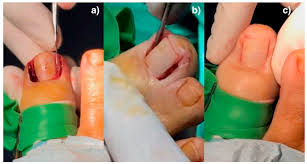Introduction
Fingernail removal surgery, medically known as onychectomy or nail avulsion, is a common procedure performed to address various nail-related issues on the fingers. However, some individuals may wonder if the same procedure can be applied to toenails. This article aims to explore the feasibility and considerations of performing fingernail removal surgery on toenails, highlighting the key differences between the two and providing insights into alternative treatment options.
Fingernail Removal Surgery: An Overview
Fingernail removal surgery is a relatively straightforward procedure that involves the removal of the entire nail or a portion of it. It is typically carried out under local anesthesia, ensuring that the patient does not feel any pain during the surgery. The most common reasons for fingernail removal surgery include severe infections, traumatic injuries, ingrown nails, and chronic nail conditions that do not respond to conservative treatments.
Indications for Fingernail Removal
Before considering fingernail removal surgery, it is essential to determine if the patient meets the appropriate criteria. Indications for this procedure on fingernails may include:
- Severe fungal infections that do not respond to antifungal medications.
- Chronic ingrown nails causing recurrent infections and pain.
- Traumatic injuries resulting in nail bed damage.
- Chronic nail disorders like psoriasis or lichen planus.
The Anatomy of Toenails
Toenails differ significantly from fingernails in terms of size, thickness, and function. Understanding the anatomical differences is crucial when considering whether fingernail removal surgery can be performed on toenails.
Toenails are thicker and more robust than fingernails due to the constant pressure they endure while bearing the weight of the body. Additionally, toenails grow more slowly than fingernails. The anatomy of toenails also includes a well-vascularized nail bed, which plays a vital role in supporting the growth and health of the toenail.
Can Fingernail Removal Surgery be Applied to Toenails?
While the principles of fingernail removal surgery remain the same, applying this procedure to toenails presents several challenges and considerations:
-
Anesthesia: Toenail removal surgery may require more extensive anesthesia due to the increased sensitivity and size of the toe compared to the finger. This can result in a longer recovery time and potential complications.
-
Recovery: Toes are subjected to more strain and pressure during daily activities, which can prolong the healing process. Patients may need to avoid bearing weight on the affected toe for an extended period.
-
Nail Regrowth: Toenails typically grow slower than fingernails, meaning that it could take a more extended period for the toenail to fully regrow after surgery.
-
Risk of Complications: Toenail removal carries a higher risk of complications such as infection and poor nail regrowth due to the unique environment of the toes.
While it is possible to perform fingernail removal surgery on toenails, it is generally considered less common and may only be recommended in specific, severe cases where conservative treatments have failed.
Alternatives to Fingernail Removal for Toenails
Given the challenges and risks associated with performing fingernail removal surgery on toenails, several alternative treatments are often preferred:
-
Conservative Management: In many cases, conservative treatments such as oral or topical medications, proper nail care, and addressing the underlying causes of nail problems can be effective in treating toenail issues.
-
Partial Nail Removal: Instead of complete toenail removal, a surgeon may opt for a partial nail removal procedure to address specific concerns while preserving a portion of the nail.
-
Laser Therapy: Laser treatments have shown promise in addressing fungal infections and other nail conditions, offering a less invasive option with minimal recovery time.
Conclusion
In conclusion, while it is possible to perform fingernail removal surgery on toenails, it presents unique challenges and considerations due to the anatomical differences between fingers and toes. Before pursuing such a procedure, patients should explore alternative treatments and consult with a healthcare professional to determine the most appropriate course of action. Conservative management, partial nail removal, and emerging therapies like laser treatment are often preferred options for addressing toenail issues while minimizing risks and complications. Ultimately, the decision to perform fingernail removal surgery on toenails should be made on a case-by-case basis, prioritizing the patient’s overall health and well-being.


